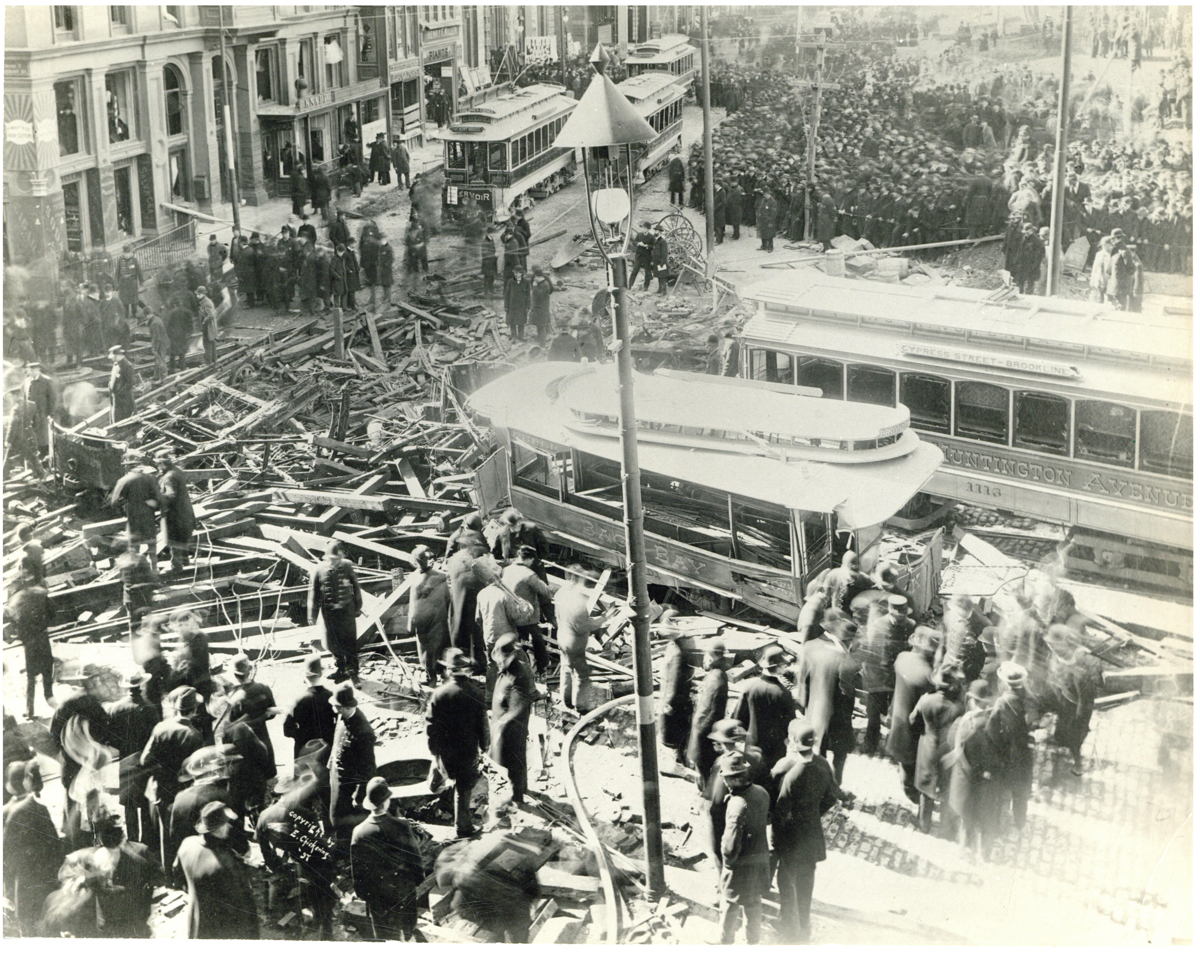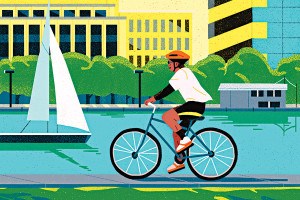A Boston Subway Documentary Airs Tonight

Gas explosion, corner of Boylston and Tremont Streets, 1897. Photo via City of Boston Archives
What is now a staple of city life here, and a resource we all love to hate, began with an ambitious idea: that Boston should build a transit system powered by electricity, and move it underground. The origin of our subway system was chaotic, it was messy, it was deadly, and it changed Boston (and the many cities that followed our lead), forever. That’s the story that the filmmakers behind The Race Underground, which airs tonight, hope to tell.
“The Boston subway was not a foregone conclusion, not by a long shot. There was a petition at one point where 12,000 businessmen opposed the subway,
says historian Stephen Puleo, according to an introduction for the documentary on an interactive website for PBS’s American Experience. “There were going to be streets torn up, sewer systems affected, water lines affected, electrical lines affected. Secondly, folks felt like traveling underground was very close to the netherworld, that you were getting closer to the devil, that you were taking this great risk in God’s eyes by traveling on a subway.”
More than a century later, the MBTA continues to evolve. An overhaul spurred on by a horrific winter that exposed just how bad the old system had gotten is underway, as is an effort to extend the length of the Green Line, and to replace hundreds of aging and unreliable train cars with shiny new ones.
And there are other bold ideas in the works, like the long-discussed underground link between North and South stations. Could Boston actually stomach another massive public works project underneath the city? Maybe there are some clues about the future in the history of the first one.
The documentary, from Newbury’s Michael Rossi and based on the Doug Most book The Race Underground: Boston, New York, and the Incredible Rivalry That Built America’s First Subway, airs at 9 p.m. on WGBH.
You can watch the first chapter here, and for the transit fanatics, there is already lots to see on the doc’s website, including an inside look at those responsible for fixing problems with the T’s ancient signals and a map of the MBTA distorted to fit on the actual map of Greater Boston.
Here’s more from the website:
In the late 1800s, Boston reigned as America’s most crowded city, with nearly 400,000 people packed into a downtown of less than one square mile. With more than 8,000 horses pulling the trolleys, the city was filthy and noisy, reeking of manure and packed with humanity.
But a young American inventor named Frank Sprague had a revolutionary idea. Inspired by his visits to the London Underground, Sprague envisioned a subway system that would trade London’s soot-spewing coal-powered steam engine with a motor run on the latest technology — electricity. After an early job with his idol Thomas Edison, Sprague launched his own venture, the Sprague Electric Railway & Motor Company. Seeking investors, he first struck out with financier Jay Gould after almost setting the mogul on fire during a demonstration. He soon found backing with the wealthy capitalist Henry Whitney, who owned a fortune in suburban Boston real estate and quickly saw the financial upside of connecting his desirable residential neighborhoods with the city’s economic center. Whitney also proposed the consolidation of Boston’s seven existing streetcar companies — all under his control. When the Massachusetts General Court granted Whitney the monopoly, he announced an unprecedented plan – to build the nation’s first subway. Powered by Sprague’s technology and enthusiastically supported by Boston Mayor Nathan Matthews, the project threw the city into a voluble debate.
‘The Boston subway was not a foregone conclusion, not by a long shot. There was a petition at one point where 12,000 businessmen opposed the subway,’says historian Stephen Puleo. ‘There were going to be streets torn up, sewer systems affected, water lines affected, electrical lines affected. Secondly, folks felt like traveling underground was very close to the netherworld, that you were getting closer to the devil, that you were taking this great risk in God’s eyes by traveling on a subway.’
The debate raged on, but the Mayor finally convinced the city that the new subway would provide much-needed jobs and not infringe on the city’s beloved Boston Common. After two years of construction, Boston’s new subway made its first trip on September 1, 1897. Despite lingering fears, more than 250,000 Bostonians rode the underground rails on its first day. In its first year of operation, 50 million passengers would ride the Boston system, and within ten years, New York and Philadelphia opened subways, with more American cities to follow.
‘Frank Sprague lived in the shadow of Edison but played as important a role in the development and growth of cities as any person in our history,’ said author Doug Most. ‘His motor is one of the most important contributions, right there alongside Henry Ford’s vehicle and the Wright Brothers’ plane, as one of the most important engineering achievements of our time.’


